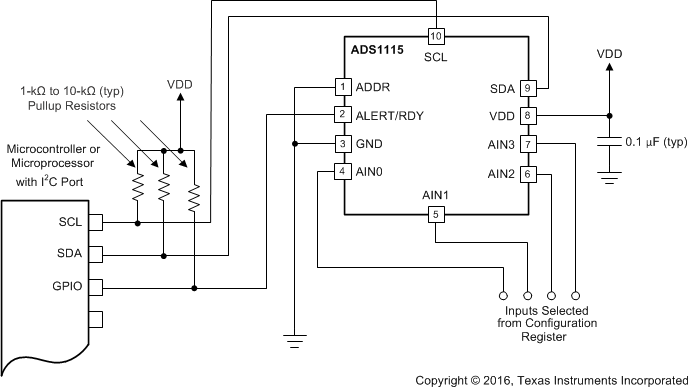JAJS373D May 2009 – January 2018 ADS1113 , ADS1114 , ADS1115
PRODUCTION DATA.
- 1 特長
- 2 アプリケーション
- 3 概要
- 4 改訂履歴
- 5 Device Comparison Table
- 6 Pin Configuration and Functions
- 7 Specifications
- 8 Parameter Measurement Information
-
9 Detailed Description
- 9.1 Overview
- 9.2 Functional Block Diagrams
- 9.3 Feature Description
- 9.4 Device Functional Modes
- 9.5 Programming
- 9.6 Register Map
-
10Application and Implementation
- 10.1 Application Information
- 10.2
Typical Application
- 10.2.1 Design Requirements
- 10.2.2
Detailed Design Procedure
- 10.2.2.1 Shunt Resistor Considerations
- 10.2.2.2 Operational Amplifier Considerations
- 10.2.2.3 ADC Input Common-Mode Considerations
- 10.2.2.4 Resistor (R1, R2, R3, R4) Considerations
- 10.2.2.5 Noise and Input Impedance Considerations
- 10.2.2.6 First-order RC Filter Considerations
- 10.2.2.7 Circuit Implementation
- 10.2.2.8 Results Summary
- 10.2.3 Application Curves
- 11Power Supply Recommendations
- 12Layout
- 13デバイスおよびドキュメントのサポート
- 14メカニカル、パッケージ、および注文情報
パッケージ・オプション
メカニカル・データ(パッケージ|ピン)
サーマルパッド・メカニカル・データ
発注情報
10.1.1 Basic Connections
The principle I2C connections for the ADS1115 are shown in Figure 39.
The fully-differential voltage input of the ADS111x is ideal for connection to differential sources with moderately low source impedance, such as thermocouples and thermistors. Although the ADS111x can read bipolar differential signals, these devices cannot accept negative voltages on either input.
The ADS111x draw transient currents during conversion. A 0.1-μF power-supply bypass capacitor supplies the momentary bursts of extra current required from the supply.
The ADS111x interface directly to standard mode, fast mode, and high-speed mode I2C controllers. Any microcontroller I2C peripheral, including master-only and single-master I2C peripherals, operates with the ADS111x. The ADS111x does not perform clock-stretching (that is, the device never pulls the clock line low), so it is not necessary to provide for this function unless other clock-stretching devices are on the same I2C bus.
Pullup resistors are required on both the SDA and SCL lines because I2C bus drivers are open drain. The size of these resistors depends on the bus operating speed and capacitance of the bus lines. Higher-value resistors consume less power, but increase the transition times on the bus, thus limiting the bus speed. Lower-value resistors allow higher speed, but at the expense of higher power consumption. Long bus lines have higher capacitance and require smaller pullup resistors to compensate. Do not use resistors that are too small because the bus drivers may not be able to pull the bus lines low.
